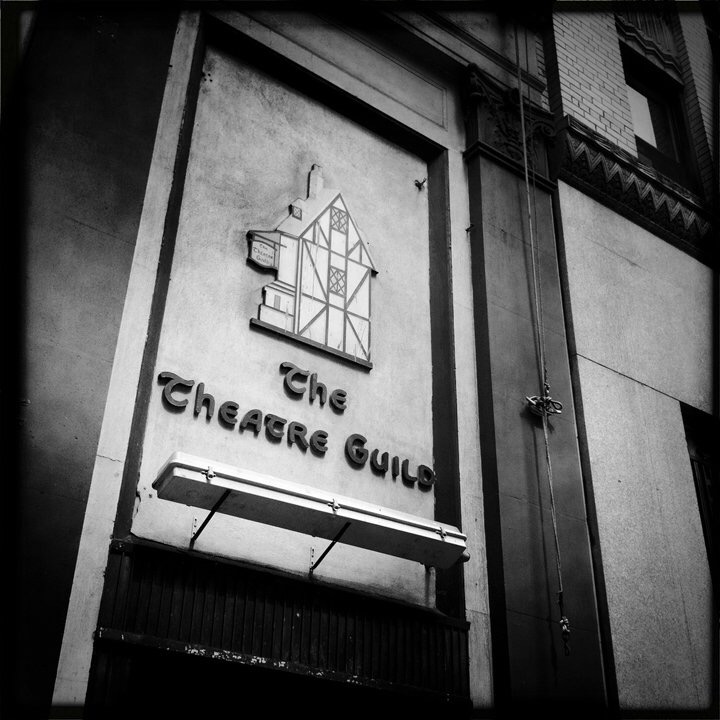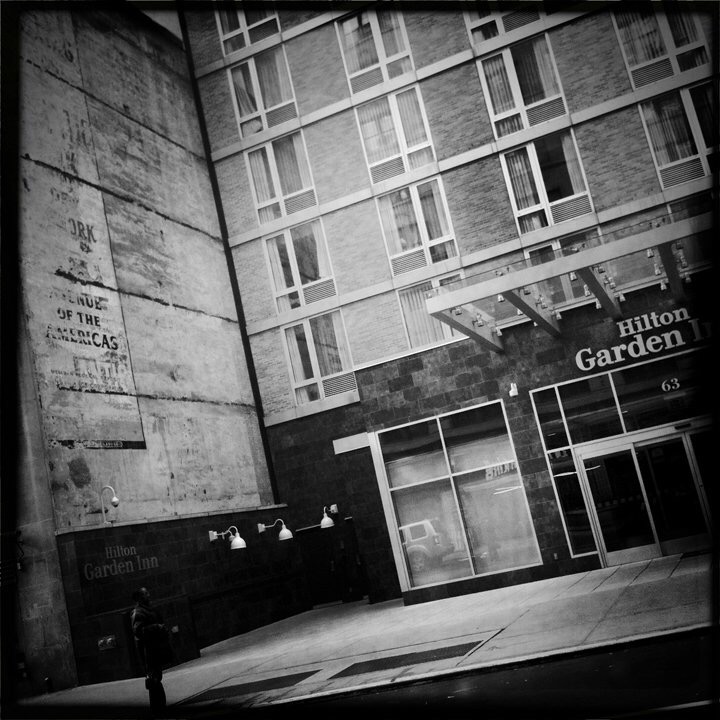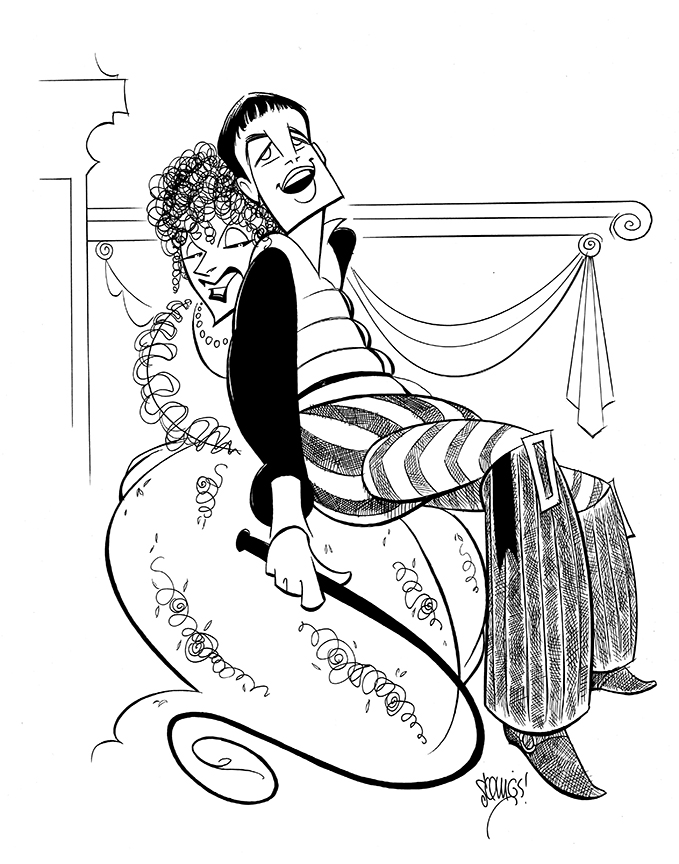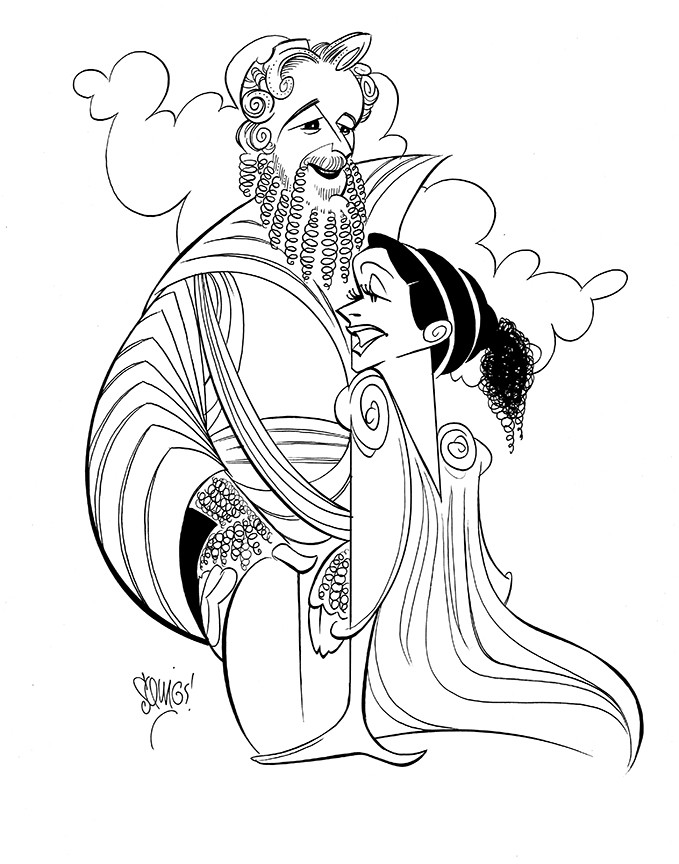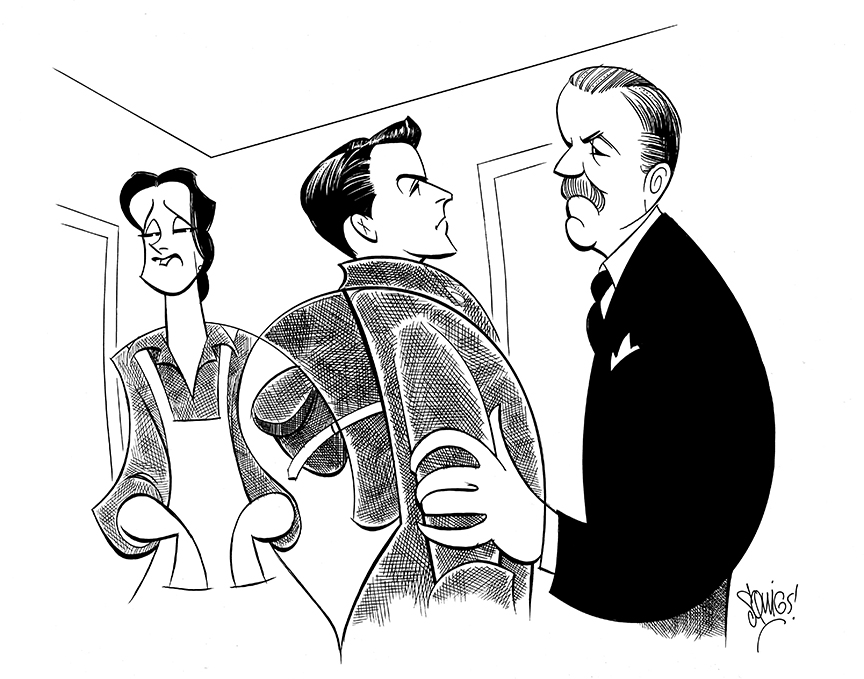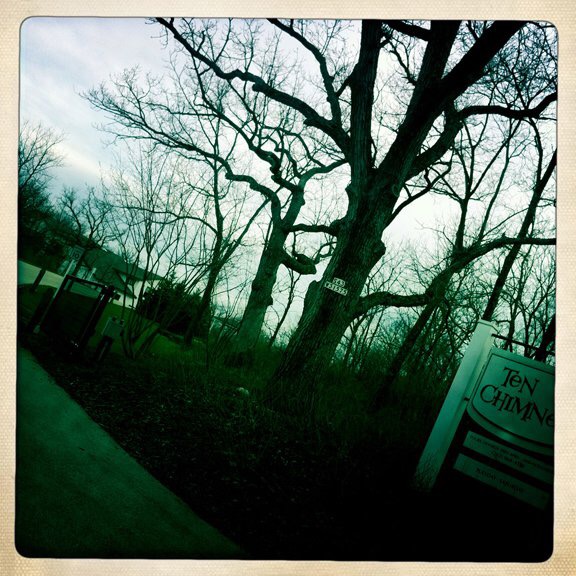The Theatre Guild logo on 47th Street, NYC.
Alfred Lunt and Lynn Fontanne, golden couple of the Broadway stage, were individually among the most popular and highest paid actors of their day. At one milestone point in their careers they signed a contract with Theatre Guild. Since they would be taking a significant cut in pay to create great art, they made two key stipulations. First, they would only star in plays together. Second, they would have summers off to spend at Alfred's childhood home in Genesee Depot, Wisconsin: Ten Chimneys. This legendary move meant that they could create a legacy of great work in New York City (and on tour) most of the year and then, in their down time, build a legacy of hospitality and fine living.
In 2010, I began a collaboration with the Ten Chimneys Foundation on an exhibit of illustrations featuring Alfred and Lynn. The exhibit would cover two facets of this couple's extraordinary life: some of their key credits on Broadway and their lives at Ten Chimneys. The exhibit was displayed at the Lunt-Fontanne Program Center for their 2011 touring season. For more information about Ten Chimneys and their wonderful tours and programs, visit their website.
ON STAGE
The Ten Chimneys Foundation chose the plays I drew, mostly focusing on just the Lunts in plays they starred in together, but including a couple of key co-stars along the way. I’ve also included photos of the theaters (or former locations) I took when the exhibit was on display:
Dulcy, Clarence
Dulcy at The Frazee Theatre, 1921; Clarence at The Hudson Theatre, 1919
This piece features Lynn and Alfred in their individual breakout performances.
The Frazee Theatre once stood on West 42nd Street. In the photo at left below, it was in the space to the right of the Empire AMC movie theatre (which was previously called the Eltinge Theatre, named for the top female impersonator of his day and during Times Square development was actually picked up and moved hundreds of feet down the street). The Frazee was gutted in the 1988 for retail space and finally demolished in 1997 during the city's new 42nd Street movement.
The Hudson Theatre on West 44th Street began as a legitimate theater, then spent many years as a television studio (the first location of The Tonight Show) and then hotel conference space. It was recently restored and designated the 41st Broadway theater, ironically also the oldest Broadway theater since it originally opened just weeks before the Lyceum and the New Amsterdam. The Hudson is currently home to Burn/This.
The Guardsman
The Guardsman at The Garrick Theatre, 1924.
This play was adapted into one of the Lunts’ only film appearances. (They preferred the stage.) The Garrick once stood on West 35th Street around the block from historic Keen’s Steakhouse. It was demolished in 1932.
Pygmalion
Pygmalion at The Guild Theatre, 1926.
The Guild Theatre is now called the August Wilson Theatre and stands on 52nd Street, now the home of Mean Girls.
Design for Living
Design for Living at The Ethel Barrymore Theatre, 1933
Lynn and Alfred starred in this play with friend and frequent Ten Chimneys guest, Noël Coward who also wrote the play. The Barrymore is currently home to The Band’s Visit.
Taming of the Shrew
Taming of the Shrew at The Guild Theatre, 1935
Idiot’s Delight at The Shubert Theatre, 1936
The Shubert Theatre, prime showcase of the Shubert organization and anchor to Shubert Alley at 44th Street, is currently home to To Kill A Mockingbird.
Idiot’s Delight
Amphytrion 38
The Seagull
Amphytrion 38 at The Shubert Theatre, 1937
The Seagull at The Shubert Theatre, 1938
There Shall Be No Night
There Shall Be No Night at The Alvin Theatre, 1940
A young Montgomery Clift joined the Lunts in this play. The Alvin is now The Neil Simon Theatre and is home to The Cher Show.
O Mistress Mine
O Mistress Mine at The Empire Theatre, 1946
The Empire Theatre once stood on Broadway between 40th and 41st Streets. It was demolished in 1953.
A print of this image was purchased by a fellow who was a stage manager for the Lunts’ national tour of this play. He gifted it to Sardi’s and it currently hangs in the Little Bar on the first floor.
The Great Sebastians at The ANTA Theatre, 1956
The Great Sebastians
The Visit
The Visit at The Lunt-Fontanne Theatre, 1959
Their last Broadway play and the only one they performed on the stage of the theatre that now bears their name, The Lunt-Fontanne on 45th Street.
AT HOME
The foundation polled the docents for their favorite stories and locations around the estate. I did my best to commemorate the stories while featuring a variety of locations and the Lunts at various ages. The folks at Ten Chimneys would name the pieces.
Gracious entertaining. The Lunts loved entertaining. During their summers in Genesee Depot, they hosted their friends from New York. We took a leap in combining a few of their regular guests around the dining table at one time: Noël Coward, Helen Hayes, Montgomery Clift, Katharine Hepburn, Vivien Leigh, and Laurence Olivier. The Lunts' hospitality is legendary.
Dedication to craft. The studio is a little barn-like structure beyond the main house and past the garden. Many a dramatic passage was rehearsed and explored in this cozy retreat.
Lifelong friendships. There is a snapshot that is featured on the Ten Chimney tours which shows Lynn dying Helen Hayes' hair in the terrace room.
Balance. Alfred and Lynn in the garden with Walter, a very protective Toulouse goose.
Mentoring. The Lunts were known for their generosity in fostering talent in others. This legacy is carried on in the Ten Chimneys fellowship which takes place each summer. They also provided work and educational experiences for many Genesee Depot locals. Setting this sketch in the kitchen shows a bit of this, as well as showing Cordon Bleu-certified Alfred pulling some of his cardamom bread out of the oven as assistant Jules works in the background.
Whimsy. We show a Christmas gathering in the flirtation room. In the background are Alfred's sisters singing, and in the foreground we see the nieces and nephew (Johnny on the concertina). A story is told of one of the kids, having been offered milk after being allowed one glass of champagne each, said, "It tastes lousy after champagne, doesn't it?"
Creativity. Claggett Wilson was a painter and theatrical designer (who had designed the Lunts' production of Taming of the Shrew). In 1938, a visit of a few weeks turned into a two-year project of decorating Ten Chimneys. This included expansive murals in the drawing room (based on Biblical stories) and, as seen here, the entry way (which featured folks in various period costumes presenting symbols of hospitality).
Retreat. The hope with this piece was to show some of the grounds. There's the pool and the pool house (topped by a mermaid weather vane gifted by Cecil Beaton) as well as the original house on the property. This cottage was sometimes called The Hen House when it housed Alfred's mother and sister.
This piece also references two infamous stories at the estate. Noël Coward was known to walk totally naked from his upstairs bedroom all the way to his dips in the pool. The Lunts failed to inform a new (and rather conservative) maid about this. On first sight of this, she quit on the spot. Alexander Woollcott (amongst a long and varied life in the arts, memorialized as the inspiration for The Man Who Came to Dinner) often wore orange pajamas in the mornings. This resulted in other guests referring to him as an enormous pumpkin.
Lasting relationships. Alfred and Lynn were known to be very competitive in their table games. Many a battle was waged in the mural-lined drawing room, and in this instance they are being accompanied by Noël Coward on the “Noëlie piano” (which is also adorned with stunning Claggett Wilson paintings).
When this exhibit was on display at Ten Chimneys, the foundation invited me back to the estate to be a guest at one of their fantastic drawing room concerts featuring Christine Ebersole and Edward Hibbert reading Noël Coward’s letters and singing his songs, accompanied on that piano.
A life well-lived. Inspired by a photo of Alfred and Lynn walking down their driveway, away from the photographer, we flipped the angle. The fellow reading Dürrenmatt's The Visit in the foreground is Joe Garton, Ten Chimneys Foundation's founder and first president who passed in 2003.
Again, if you’d like to learn more about Ten Chimneys and/or want to visit, check out their website.
Genesee Depot, Wisconsin is a small unincorporated community located between Milwaukee and Madison. Once a whistle stop on the railroad that passed through town, the residents were very protective of their famous residents, often giving visitors incorrect directions when they asked where the Lunts lived.
Ten Chimneys became a National Historic Landmark in 2003.
The entrance and winding road to the The Lunt-Fontanne Program Center.
As I wandered NYC’s Theatre District in 2011 taking the theater location photos above, I dressed for the occasion.
Ten Chimneys (photographer unknown)

